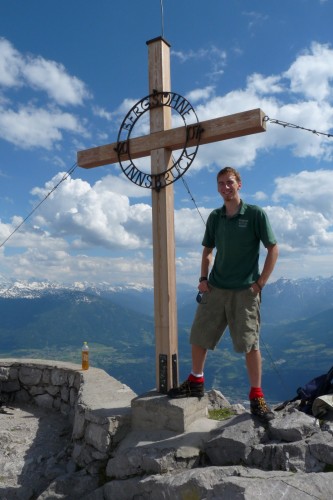
One of Dani's pictures from the top of Hafelkar, an easily-accessible mountain overlooking Innsbruck
Note: to get a birds-eye view of the city as I saw it from the top of Hafelkar, download this Google Maps .KMZ file with some extra details added in!
Using my encyclopedic knowledge of Salzburg after three days of living there, getting back to the train station with my heavy bags in hand was an easy task. My Salzburg card had expired the previous day, so unfortunately the 2 euro buses were a luxury that I didn’t feel were justified by the relatively short hike from the hostel to the station.
On the train, I shared a six-seat train car with a 30-something year old Viennese woman named Isabella, who was on her to Innsbruck to visit her Italian boyfriend who worked in a casino. She and I spent the two hour ride in animated conversation about Austrian and EU politics compared with Jordanian and American, and the always-lamentable state of American “semi-apathy,” a term that I described to a Madison newspaper several years ago as the common mindset with liberal university students where they believe that voting for Barack Obama will somehow create world peace. “I don’t need to talk about the antiwar effort,” they’d tell me apologetically over their bottles of Jack Daniels while reaching for their television remotes. “I’m voting for Obama; he’ll take care of this terrible mess in Iraq.” Isabella rolled her eyes sympathetically.
My journey to the mountain city/town of Innsbruck was in place long before I had considered visiting Salzburg. A coworker of mine at PTEE has many ties to the community of Innsbruck, and even got married there a few decades ago. Without exception, all of his children have gone to school in Austria, and two of them live in an apartment on the outskirts of the city, with the mountains pressing so close to them that it seems like the sun is actually rising later and setting earlier! After securing their permission, my coworker invited me to stay at their place and relax between my weeks of hostel-jumping, an offer I could not refuse.
I had been in communication with his son, Dani, for a few months before coming and we had thought we’d be coming into the train station at the same time from different parts of the country. But as I sat there on my bag after Isabella had directed me to the front gate, it became readily apparent that there was no one coming. I halfheartedly tried the payphones, but in this age of mobile phones, they appeared derelict and two of the three didn’t even produce a dial tone. I was too shy to ask to borrow someone’s mobile, so with Dani’s email describing how to find his house by bus (thank goodness) I set out to attempt to find my own way through the city to his residence.
The bus drivers helpfully deposited me on a street in the sunset-streaked suburbs, but I could not find any sort of house numbers. I wandered with my luggage up and down the street for half an hour before finally finding a tiny side street that appeared to lead to an apartment building with the right number on it. I rang the unnamed buzzer, but no one answered. Feeling the need to search for a bathroom, I left my luggage and ran up and down the street, hunting for any sort of public building and sticking my head into a Catholic church with some sort of choir concert going on, but once again my efforts were stymied. I curled up on the porch of the building, attempting to think of anything but liquids, and it was about then that a dark-haired teen-aged girl happened by and unlocked the door. She didn’t speak any English at all, but I knew how to say “Dani” and “handy” and apparently she understood that I wasn’t insane and wanted to use her “handy” (the German word for “mobile” or “cell phone”) to call her neighbor Dani.
He greeted me enthusiastically over the crackling connection and explained that his train had been two hours late but he’d be there in fifteen minutes or so. The girl brought her mother out, who invited me into their home (and their bathroom, thank goodness) and then started feeding me some sort of breaded fish and pastries. I learned that they were a Muslim family from Turkey, but they’d been in Austria for over a decade, speaking German to the outside world but maintaining their cozy Turkish-speaking customs within their own walls. Dani showed up a few minutes later, slapping me on the back, and was promptly handed a plate of food as well.
I immediately liked the tall, shaggy-haired young man, who has the same fast-talking, easy-going mannerisms as his father Robert. He explained that his sister was gone for the weekend, and that we’d have the place to ourselves. He showed off the apartment to me, filled with bric-a-brac from America, Jordan, and Europe. As Dani had grown up to American parents in Jordan but spent years in Austria, he spoke all three languages with fluent ease and told me he was learning Swahili at the moment. As the sun vanished over the tops of the mountains, Dani smiled slyly at me and started whipping up dinner for the two of us: Pork sausages wrapped in Pork bacon, stuffed with cheese. “I had an idea that a dinner like this might appeal to you,” he grinned.
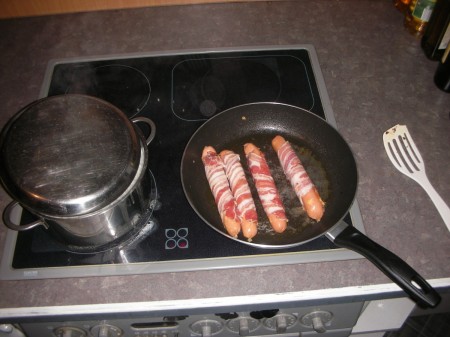
It's almost like he could read my mind. More likely, he was remembering what it was like to come from Jordan to Austria!
After dinner, he and I sat at the kitchen table until after midnight, discussing religion and politics of Jordan, America, and Austria. I was impressed by his straightforward ideas on spreading Christianity to a disillusioned population of Austrian youth, and doubly so by his goals of using his future degree in medicine to aid impoverished African nations. I thought back to Robert’s own efforts in Jordan over the decades and realized the apple hadn’t fallen far from the tree! As we finished off the bottle of Chimay beer that I’d brought from Belgium, we consulted about what I should spend my two days in Innsbruck doing. He wrote up some maps and made some recommendations, then told me to set Sunday afternoon aside for a mountain climb! I could see the moonlight twinkling off of snow even in the darkness outside, and thought of hitting those slopes in my hiking boots was really exciting.
The next morning, we had breakfast out on the balcony, and then while Dani began studying for his final exams, I started off on my own. I visited the “Rose Chapel” (not an actual name) that I could see from my bedroom window on the hill south of the city, giving my first chance to look out over Innsbruck. After taking a few pictures and descending, I retraced my bus route from yesterday and beelined straight for the Tourist Information center to purchase the familiar-sounding “Innsbruck Card,” which would give me free access to all museums, cable cars, and public transportation – an identical list to the Salzburg card I had used a few days ago.
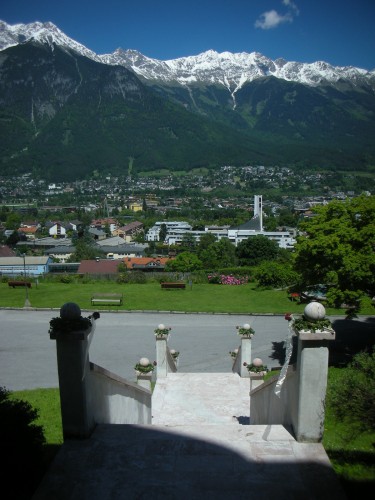
That church spire you see here from the steps of the Rose Chapel is two buildings away from Dani's house
Although I’d never heard of it before, the most famous landmark in the Tyrol region of Austria was only a block away from me. “The Golden Roof” is apparently featured on Austrian coinage, and is so beloved by its people that precious cement was used during World War II to build a massive silo around the front of it to protect its ornate, shimmering shingles (which are actually made of copper, not gold; I doubt they would have lasted for 500 years if that had been the case). The roof was pretty, to be sure, and there were some excellent carvings around its edges, but I found the museum in the same building much more interesting. I spent a couple hours wandering through its well-labeled halls with my audio guide, listening to the narrator describe the life of Emperor Maximilian I, who had loved Innsbruck and was known for watching sporting matches from the deck underneath the Golden Roof. His rugged looks, famous broken nose and reputation of a sportsman were part of the legacy that made him known as the “Last Chivalric Knight.”
The museum tour ended with the cryptic note that although Emperor Max wasn’t buried here in Innsbruck, his descendants wished to honor his love of the mountainous countryside and made a massive cenotaph here in Innsbruck. It was a five minute walk from the Golden Roof building to the Hofkirche that housed the large and empty tomb. The original plan had been to move the Emperor’s remains to this location so that the dozens of life-sized favorite ancestors and Max’s heroes could watch over him, but instead the tomb was kept empty, with the last statue kneeling on the top, broken-nosed face bowed toward the cross. Emperor Max, who had asked that his hair be shaved and his teeth torn out after death “in the way of the martyrs of God,” would have approved.
I spent a few hours touring the Grassmayr Bell Museum in the south part of town, looking in vain for the picture I found in the Innsbruck Card information packet showing well-insulated burly fellows pouring molten bronze into chambers as sparks and fire flew off in all directions. Maybe because it was Saturday and half an hour from closing time, but the place was abandoned except for me and an Italian tourist. Even without the fire and exploding, it was an interesting little museum, displaying creation techniques and replicas of some famous bells the Grassmayr family had made in their 400 year old tradition. Attached to their darkened workshop was a little room where you could test out the bells and see some of their interesting physics properties, like the video below.
I found myself walking near the large an imposing facade of the Jesuit Church of Innsbruck when their prayer bells started going off at around six in the evening. Near the doorway, I heard two women conversing in Britain-accented in English, and turned my head in their direction as they walked into the crypt entrance near front door to the church. A sign on a hook nearby: “English Mass service held every Saturday at Six.” I figured it was providence, so I holstered my camera and followed them down through a long tunnel that opened up into the main crypt room which must have been right about under the alter, a 15 meter walk.
Interestingly enough, this was the first Catholic Mass I’ve ever attended. As I listened to the priest intone rites that I’d never heard before, I thought of the irony that I was an American Lutheran, coming from Jordan to Austria, in a German-language Catholic church, listening to an Indian priest give Mass to a congregation of British people plus me. I was by far the youngest in the group, and my middle-aged fellow congregants appeared fairly bored with the priest, and I wondered if they were tourists or British residents in Austria. The poor gentleman was definitely having some difficulty, and he read the sermon off of a series of printed notecards in what appeared to be verbatim and blinked nervously a lot. I wondered how he had managed to draw the short straw for this job of ministering to disinterested foreigners.
As it was Saturday evening in the extremely Catholic city, when I emerged from the church everything was closed and people looked as if they were heading home, with the exception of other tourists such as myself who were peering at maps as if trying to will something to be catering to their sightseeing needs. I contented myself with crossing the “Brucke” over the “Inn” River – that is to say, the modern interpretation of the historic Inn Bridge from which the city took its name in 1180 AD – and walking through the parks along the river’s edge and dodging bicyclists. Compared with Jordanian bicycling (basically nil outside of clubs like Cycling Jordan) any appreciation of the sport would seem large, but we collegiate Americans have nothing on Germany and Austria from what I’ve seen.
The next day was split in two; pre-Mountains and Mountains. During dinner after I got back, Dani and I had agreed to meet up near the Hofkirche at noon but I had the morning to myself. Being a sportsman, he had recommended to me that I check out the famous “Bergisel Ski Jump,” a towering structure that I had already glimpsed from the bell museum. “You can have your fill of castles and history in Vienna,” Dani told me knowingly. “But it’s out here you’ll get the mountains and the incredible sports that come with them!” The snub-nosed construction of green glass and concrete wasn’t hard to find again, and my Innsbruck Card easily got me a ticket to the short tram to the top of the jump. Taking the slow moving vehicle up the hill gave me time to think of what it must feel like to fling yourself down this thing at 90KM/h, skimming across this mountain and hoping that you don’t overshoot the landing pad near the admission booth.
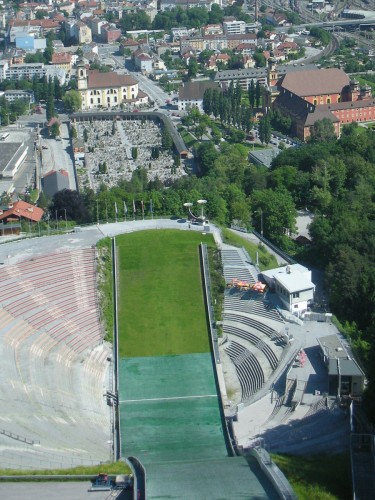
Just in case, a large cemetary just beyond (and 80 meters below) the landing pad is conveniently located for those who overshoot
Being at the top afforded some great views to the north, and if I squinted, I could make out a gleaming silvery-gold dot in the middle of town that I knew was The Golden Roof. The northern mountain range dwarfed everything else, and it was exciting to know that in only a couple hours I’d be on the summit of one of them. The faux “grass” on the hill actually seemed to be made out of nylon wires or wrappings, and I wondered what it felt to land on. When I exited the lift at the bottom, a group of sporty looking young guys took my place. I noticed one of them was dressed in pads and was carrying a set of skis with him, and the others were slapping him on the back. He couldn’t possibly be making a jump in June, I mused to myself. I wanted to stick around a bit to see if he’d go soaring off the edge of the jump, but time was running out and I needed to get to our meeting point.
After our rendezvous, Dani and I were able to put the Nordkettenbahn funicular’s claims to the test. “Twenty minutes from the city center to 2256 meters above sea level!” the advertisements in English proclaimed. Dani, an avid snowboarder, already owned a year-long pass, and my Innsbruck Card worked here too. The smooth-riding cars had a unique rotational system on their bearings, allowing each one to separately swivel several degrees depending on whether the funicular was moving along level earth or up the steep mountain slopes. We had to switch cars halfway up to a less modern-looking cable car instead of the funicular, but I enjoyed peering down at the slopes underneath us, watching mountain bikers take insane leaps off of cliffs on bikes that probably cost more than my entire university education. Dani smiled as he watched them; the previous day he had been out there with them during a study break in the afternoon.
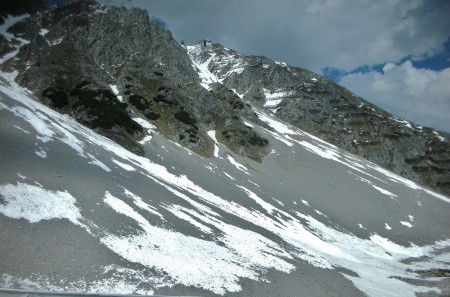
That tiny building in the picture is the final stop on Hafelkar summit. Below it are the avalanche barricades; each one is 2 meters wide. The remainder of our journey!
The air was noticeably chillier as we disembarked at the last (working) stop at Seegrube. Innsbruck was laid out below us like a glowing, poorly-exposed quilt and behind us on the mountainsides the snow was bright enough to cause retinal detachment. Even from behind my shades, it was barely viewable and I had to crank the exposure setting on my camera down to -1.7 to get anything besides white blurs on it. We stood for a moment on the edge of the cliff, watching the hang gliders and ultralite flyers buzzing around below our ankles. A few ravens wheeled above us, scanning the picnic tables of the outdoor cafe in the dropoff point for a snack. One suddenly dived around in an arc, and as I tracked it, it suddenly released an aerial attack from its rear which splattered on the concrete where I had been standing seconds earlier before leaping out of the way. “Hike up the rest of the way, then?” Dani said with amusement. “Quickly, before they rearm!” I responded.
There was technically one more cable car up to the summit of the Hafelkar mountain, but it didn’t seem to be working, which was fine by us. Above us were the cliffs, boulders, shrimpy shrub grass, mountain goats, and weather-beaten metal sculptures which Dani told me were avalanche protection systems. Our hiking path was marked by red spray paint on the rocks every couple dozen meters, which I figured probably had to be redone every year after the 3-meter deep snows on these cliffs scrambled up the rocks into entirely new locations, possibly the bottom of the mountain. After slathering ourselves in sunblock to guard against the intense UV rays, we scrambled up the trail in amicable conversation, with me following my much more experienced friend as he picked out the trail.
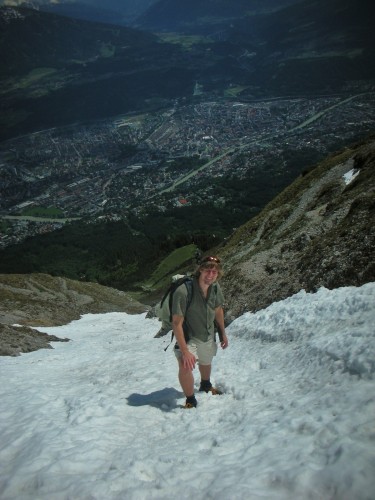
Dani squints up at me from our snow-creek climb. Directly over his head on the opposite side of the city, you can see the Bergisel jump
About thirty minutes into the climb, our path intersected with what would normally have been an “ice-cold” mountain stream, but thanks to the precipitation Austria had been receiving, both here and in Salzburg, it was just “ice” instead. I was already sweating from exertion and exposure, and suggested that we switch from the path, to the steep fissure of crunchy snow instead. I found that even without long spikes on the toes of my boots, it was a pleasant way to climb, and I took the lead, kicking and stabbing each boot-toe into the ice and half-climbing, half-falling into the snow. In that way we made it up to the summit in about 75 minutes, just in time to learn from the ponytailed young man attending the lift that the last one back to the start of our hike at Seegrube would be leaving in 15 minutes. “Not nearly enough time for us to eat,” Dani said. “We’ll just need to make sure we’re back down at Seegrube before 5:30. No problem, right?”
It was incredible to have lunch up there at the peak, sitting under that Summit Cross you see in the opening picture for this post. Dani had come fully equipped for the meal, with local cheese and jerky, homemade bread and a pungent spicy mustard from a toothpaste-like tube. Besides that, we had our raisins and nuts, apples and tomatoes. We feasted like kings up there, watching pinpricks of light move on the mottled surface of the city far below us as cars moved across the Inn river’s bridges. Mountain sheep with bells inexplicably around their necks grazed sleepily below us, moving from hillock to hummock with ease in their search for the tiny bits of tundra grass here above the treeline. It was hard for me to remember that in another three days I’d be back in Jordan; I was a world away from it here.
The descent down the mountain was just as interesting, although in a completely different way. It wasn’t until 5:05 that we realized that if it had taken us an hour and a quarter to get up the mountain, how long would it take us to get down? Dani grinned and said, “Well, I guess we’ll have to freerun it.” Thus began a rather terrifying 20 minute descent, gamboling down the tiny narrow trail and leaping across snowy patches at a rate of speed that, had I been safely watching instead of partaking, I would have characterized as “ridiculous.” Dani effortlessly bounced off of rocks like a mountain goat, and I did my best to keep up although I knew he was holding back for my sake. I knew that I was one fast-moving footstep away from a twisted ankle, or worse, an uncontrollable skid that would leave me bouncing and twisting into the treeline 300 meters below us. Gasping and panting, I was only 30 seconds behind him when he bounded, deer-like, into the building at 5:25. “You did awesome, man” he greeted me when we were safely back into the descending cable car, leaving the Seegrube stop behind. “Most of my friends would never have been able to keep up with me like that. I do that sort of downhill run all the time. That was really impressive.” I think I probably wheezed something along the lines of, “The incentive was not to have to walk the rest of the way back into Innsbruck.”
For my last night in Innsbruck, I shared my father’s famous burrito recipe with Dani and his sister, who had returned from her weekend getaway. Dani even showed me how to make my own tortillas, and I broadcast the result over a Skype video conference to my father back in Wisconsin. I knew that I’d be getting up quite early tomorrow – today – to take the 5 hour train ride from Innsbruck, all the way across the country to Vienna. One thing’s for sure though – so far, out of my entire past two and a half weeks of vacation, this beautiful city with its silent stone sentinels has been my favorite place to relax and take in some splendor.
Note: to get a birds-eye view of the city as I saw it from the top of Hafelkar, download this Google Maps .KMZ file with some extra details added in!
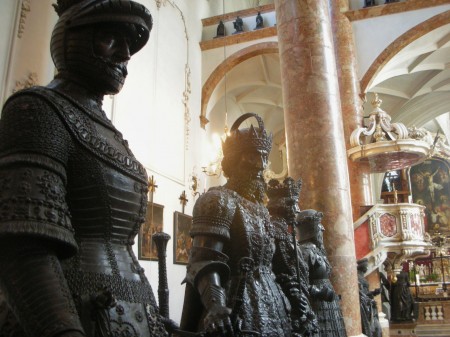
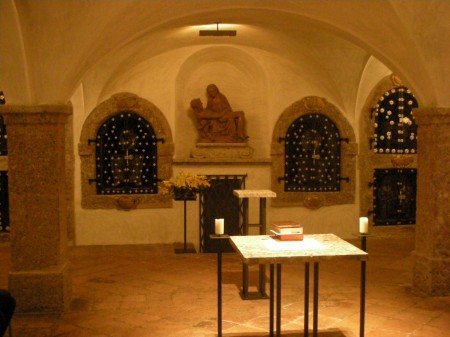
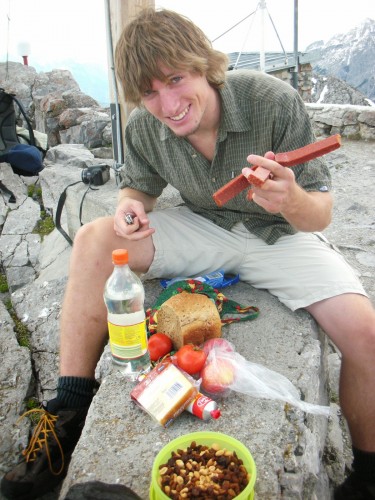


Wow — I wish you’d been able to shoot video while flying down the mountain — sounds amazing! How many feet of altitude / miles do you suppose you covered in that 20 minutes? Glad you’re still in one piece!
Although the Golden Roof “shingles” may be made of copper, they are covered with real gold if they were fire-gilt — some 15th-century artisans probably sacrificed their brains via mercury toxicity to make them, according to the wiki: http://en.wikipedia.org/wiki/Gilding#Fire-gilding